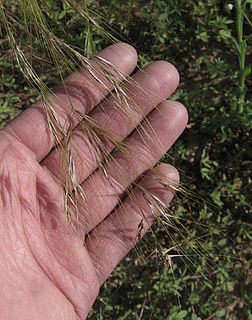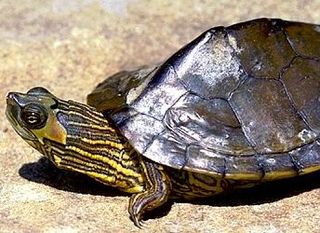
Stipa is a genus of around 300 large perennial hermaphroditic grasses collectively known as feather grass, needle grass, and spear grass. They are placed in the subfamily Pooideae and the tribe Stipeae, which also contains many species formerly assigned to Stipa, which have since been reclassified into new genera.
Claudia Pulchra was the name of several women of Roman gens of Claudii during the 1st century BC and 1st century AD. The Latin pulchra is the root of the English word pulchritude.

The banded bullfrog is a type of frog in the microhylid family. It is also known as the Asian painted frog, rice frog, and bubble frog. In the pet trade, it is sometimes called the chubby frog. They have round bodies with mahogany brown backs and cream stomachs. The distinctive stripes down the side can range from copper-brown to salmon pink in color. Males have darker throats than females. Frogs grow to about 8 cm (3 in) with females generally being larger than males. They may live for as long as 10 years. kaloula Pulchra, although prevalent in the pet trade, very little is known regarding its behaviour in the wild. they exude a sticky mucus when threatened.

Nassella pulchra, basionym Stipa pulchra, is a species of grass known by the common names purple needlegrass and purple tussockgrass. It is native to the U.S. state of California, where it occurs throughout the coastal hills, valleys, and mountain ranges, as well as the Sacramento Valley and parts of the Sierra Nevada foothills, and Baja California.

The rose-faced parrot is a species of parrot in the family Psittacidae. It is sometimes considered conspecific with the brown-hooded parrot, and was formerly placed in Pionopsitta which is now monotypic. It is found in Colombia and Ecuador.

The beautiful jay is a species of bird in the crow and jay family Corvidae. It is closely related to the azure-hooded jay, and the two species are considered sister species. The species is monotypic, having no subspecies. The specific name for the beautiful jay, pulchra, is derived from the Latin word for beautiful.

The montane monkey-faced bat is a megabat endemic to the Solomon Islands. It is listed as a critically endangered species. Due to its imperiled status, it is identified by the Alliance for Zero Extinction as a species in danger of imminent extinction. In 2013, Bat Conservation International listed this species as one of the 35 species of its worldwide priority list of conservation. Only one individual has ever been found.

Anniella pulchra, the California legless lizard, is a limbless, burrowing lizard often mistaken for a snake.

The Alabama map turtle is a species of emydid turtle endemic to the southern United States. Differentiation from other turtle species includes a black stripe running down the center of its back with knobs extruding from it, but these projections wear down with age. T.H. Bean and L. Kumlen first collected the Alabama map turtle in July 1876 from a lake near Montgomery, Alabama. Type locality for this species is Montgomery County, Alabama. Baur described and named the Alabama map turtle in 1893. The genus Graptemys includes nine species of mostly aquatic turtles.

Nepenthes pulchra is a tropical pitcher plant endemic to the Philippine island of Mindanao, where it grows at 1300–1800 m above sea level. Its discovery was announced online in August 2011.

Tota pulchra es, WAB 46, is a sacred motet by the Austrian composer Anton Bruckner.

Sophronica is a genus of longhorn beetles of the subfamily Lamiinae, containing the following species:

Crepis pulchra is a European species of flowering plant in the daisy family with the common name smallflower hawksbeard. It is widespread across much of Europe as well as in Morocco, Algeria, and western and central Asia. It has also become naturalized in the parts of the United States and in the Canadian Province of Ontario.
Sophronica bimaculipennis is a species of beetle in the family Cerambycidae. It was described by Stephan von Breuning in 1955, originally under the genus Sophronisca. It is known from Ghana, the Ivory Coast, and Guinea. It contains the varietas Sophronica bimaculipennis var. besnardi.
Sophronica rufulescens is a species of beetle in the family Cerambycidae. It was described by Stephan von Breuning in 1940. It feeds on the Monterey Pine.
Sophronica subdivisa is a species of beetle in the family Cerambycidae. It was described by Stephan von Breuning in 1940.
Sophronica angusticollis is a species of beetle in the family Cerambycidae. It was described by Per Olof Christopher Aurivillius in 1928. It is known from Somalia, Ethiopia, Tanzania, and Kenya.
Sophronica grisea is a species of beetle in the family Cerambycidae. It was described by Per Olof Christopher Aurivillius in 1908.
Sophronica amplipennis is a species of beetle in the family Cerambycidae. It was described by Francis Polkinghorne Pascoe in 1888.











